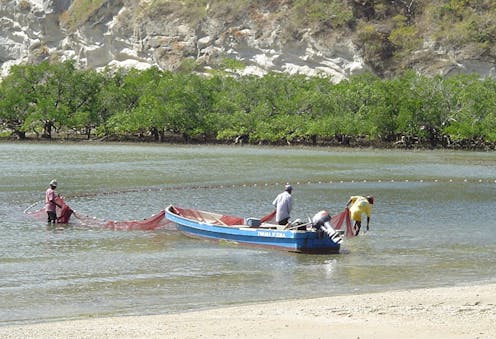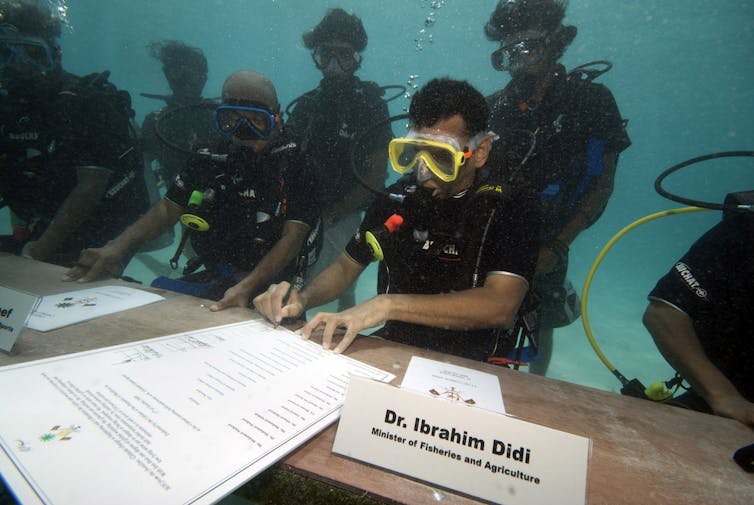Lost in translation: What spirituality and Einstein’s theory of time have to do with misunderstandings about climate change
- Written by Miki Mori, Associate Professor of Linguistics, Université de Mayotte
 Fishermen on Mayotte, where the local Maore language has no words to easily translate 'climate change.'
Mwanasimba via Wikimedia, CC BY
Fishermen on Mayotte, where the local Maore language has no words to easily translate 'climate change.'
Mwanasimba via Wikimedia, CC BYAs a child growing up in the early 1990s, I remember learning in school about the greenhouse effect. Carbon dioxide released by burning fossil fuels traps heat near the Earth’s surface, like the glass of a greenhouse. I imagined myself on the playground, roasting inside a humid hothouse.
Fast forward 30 years, and the terms have changed.
For a while, “global warming” was the go-to expression for talking about rising global temperatures and the role of human activities, particularly the use of fossil fuels. It had a spike in internet searches in 2007, probably due to former Vice President Al Gore’s documentary “An Inconvenient Truth: A Global Warning,” which hit theaters in 2006.
Near the end of the Obama administration, “climate change” became the most common term. It’s now trending in Google searches more than global warming. Both terms make the same point: Rising global temperatures have major consequences on local weather patterns and worldwide climate effects, including stronger hurricanes, droughts, floods and fires.
However, the words we use to discuss these effects can make a large difference in how people understand the risks and the need for more sustainable choices.
What’s in a name? A lot, it turns out
I’m a linguistics researcher currently living on Mayotte Island, off the coast of Madagascar, where I study climate change knowledge among local populations and the language they use to discuss it.
Local fishers on Mayotte struggle to talk about the phenomenon because there is no established terminology for it. What my colleagues and I have learned offers some insight into the difficulties people in many cultures have with understanding climate change.
In the grand scheme of climate change education and sustainability efforts, this seemingly minor problem of translation is in fact symptomatic of a larger underlying issue regarding the relationship between humans and their environment.
In fact, when we dig deeper into challenges of communicating climate change across cultures, two factors come into play: spiritual beliefs and notions of time.
Spiritual language can overlap
Spiritual and religious beliefs can play an important role in how climate change is understood and even named. For example, the translation for the term climate in Inuktitut, an Inuit language spoken in Canada, is “sila.” However, sila also refers to wisdom, the spirit, the earth, and the universe. It is something sacred to be revered.
Seen through the lens of this second set of definitions, sila is effectively impossible for people to influence. It is beyond humankind’s reach to change the cosmos. As a result, communication aimed at promoting awareness of climate change becomes politicized in Eastern Canadian Inuit languages.
My colleagues and I encountered similar challenges while discussing possible future efforts to slow down environmental destruction caused by climate change on Mayotte.
The Maore fishers we interviewed, many of whom were of a deep Islamic faith, often responded with “Inshallah,” or God willing, when questioned about efforts the community could make in the future to address the problem. They saw these climate change-related events as out of their hands, as something only God could interfere with.
People understand time in different ways
Second, we might think that time is objective and therefore shared across cultures. But as Albert Einstein argued, time is relative.
Time is not only relative scientifically speaking, but also culturally. For example, the ancient Greeks had more than three types of time, one of which we still use today, Kronos, or linear time – think chronological order. We have all but forgotten Aion, or sacred, eternal time, and Kairos, or cyclical time.
Notions of time play an important role when thinking about climate change, since the heart of the phenomenon involves a slow, continuous change over a long period. We cannot see climate change happen with the naked eye, because it occurs over years and decades. Of course, we can see its effects on weather patterns, including extreme heat waves and heavy downpours.
 Some lawmakers in the Maldives, an Indian Ocean nation threatened by sea level rise, have pushed for urgent action to slow climate change, including famously holding a Cabinet meeting underwater in 2009. But that sense of urgency conflicts with belief systems among some in the population.AP Photo/Mohammed Seeneen
Some lawmakers in the Maldives, an Indian Ocean nation threatened by sea level rise, have pushed for urgent action to slow climate change, including famously holding a Cabinet meeting underwater in 2009. But that sense of urgency conflicts with belief systems among some in the population.AP Photo/Mohammed SeeneenGetting people to think about time in a way that simultaneously thinks about the now, and a “then” in the distant future proves to be challenging in many cultures.
For example, researchers studying sustainability efforts in the Maldives Islands have come up against this very issue. While discussing time, many local residents think in terms of the now and the near future, whereas policymakers must think about longer-term effects on a larger scale. These contrasting approaches to time have made it difficult to put into place sustainability efforts to tackle rising sea levels – a significant threat to this tropical nation of 26 atolls.
Translating climate change
A first step to confronting this problem is to put language at the forefront of climate change education efforts.
One youth-driven nonprofit making strides in this area is Climate Cardinals. The group’s objective is to translate climate change research into as many languages as possible. Most scientific studies and reports are in English, which can be a barrier to the many non-English speakers around the globe. In their efforts to translate this research and related phenomena, they need to think carefully about how important words are translated and understood.
Sophia Kianni, the young founder of Climate Cardinals, talks about how translations can help people around the world understand the threats of climate change.The United Nations and other groups are also starting to take seriously the connection between climate change skepticism and religion, including the need to reconcile eventual points of friction.
For example, the Faith for Earth Initiative works with religious organizations to address the compatibility of sustainability efforts and faith. It does this by helping religious leaders connect core spiritual values, like caring and rejection of greed, to the community’s environment, thus reconnecting with nature and seeing themselves as its stewards.
Finally, it is imperative to keep studying local or indigenous knowledge about the environment as related to change and time. The ancient Greeks certainly had their reasons for dividing time into multiple categories. So what were the environmental and historical influences that led them to do so?
For instance, researchers and community members in Australia are looking to reconcile Indigenous knowledge with Western science. Thanks to the locals’ long-standing observations of their environment over several generations, they were able to identify local effects of climate change. Such information is often overlooked and difficult to obtain by traditional research methods.
Beyond the headlines
Climate change awareness and sustainability efforts will only increase over time. Care needs to be taken to how these concepts are lived, understood and talked about in non-Western settings. Language is part and parcel of these efforts and deserves to be considered more carefully.
Miki Mori received funding from the Mission for Transversal and Interdisciplinary Initiatives of France's National Center for Scientific Research for the project in Mayotte.
Authors: Miki Mori, Associate Professor of Linguistics, Université de Mayotte

